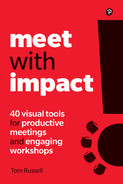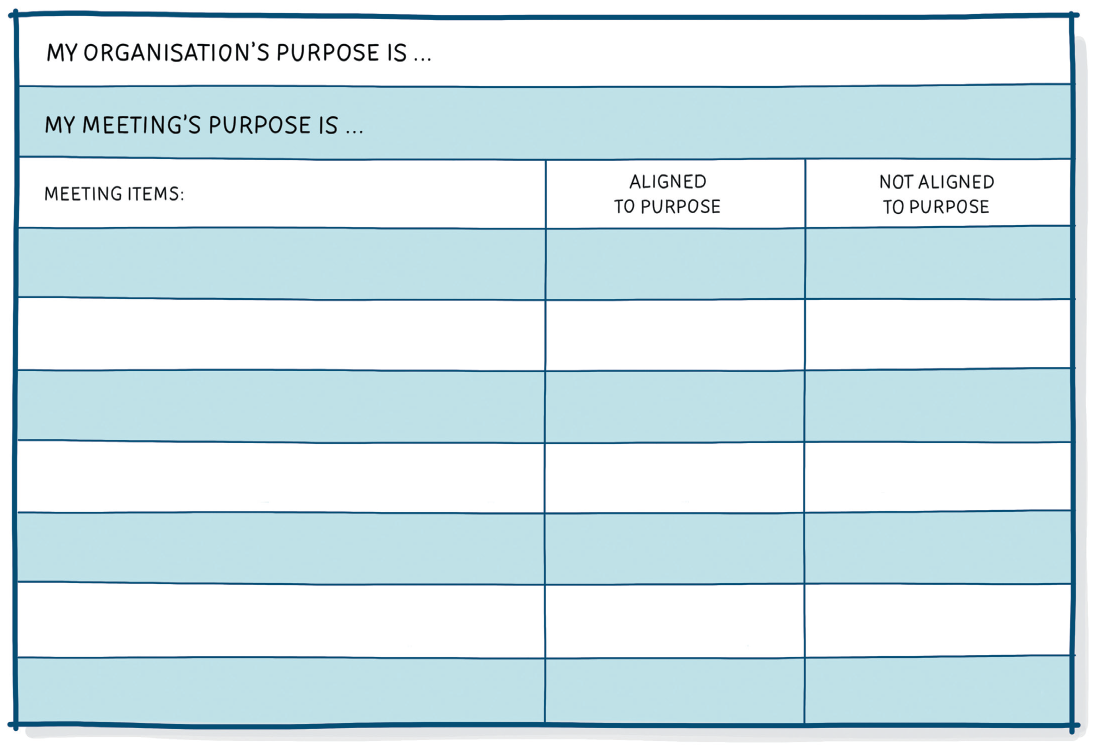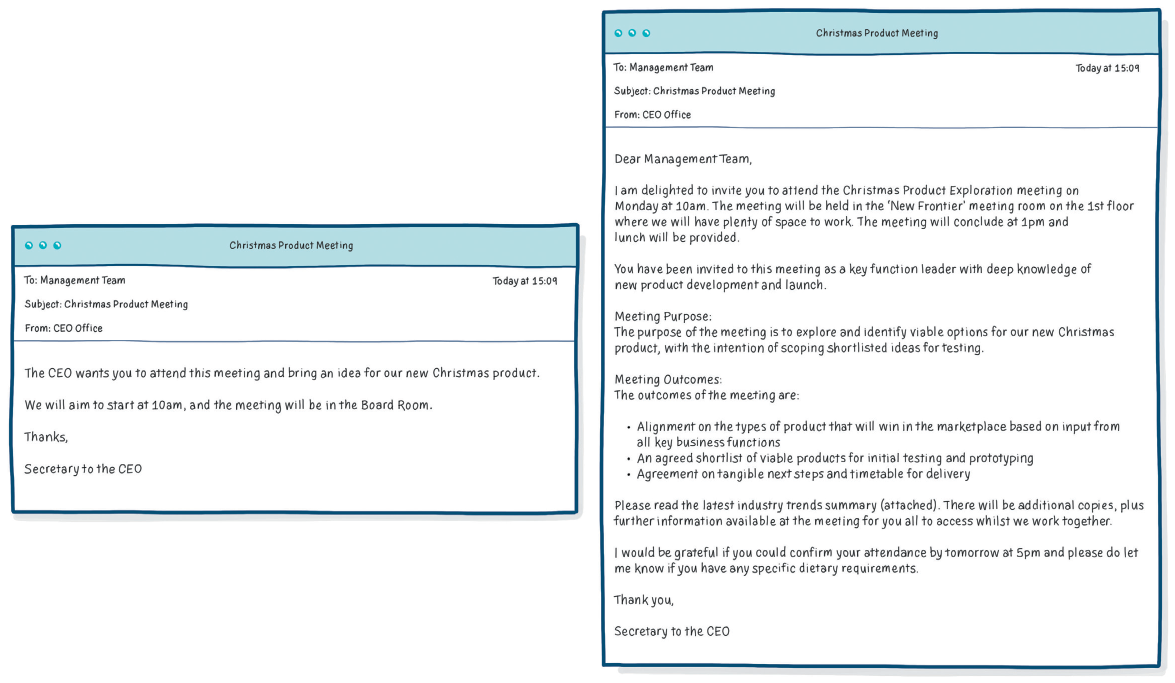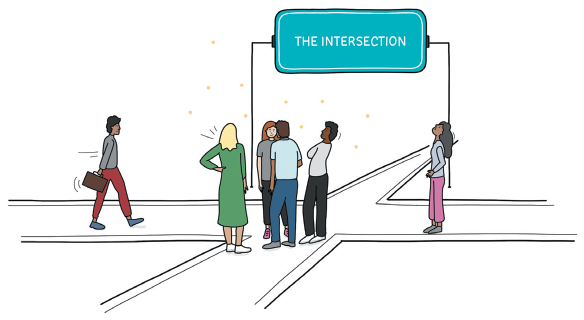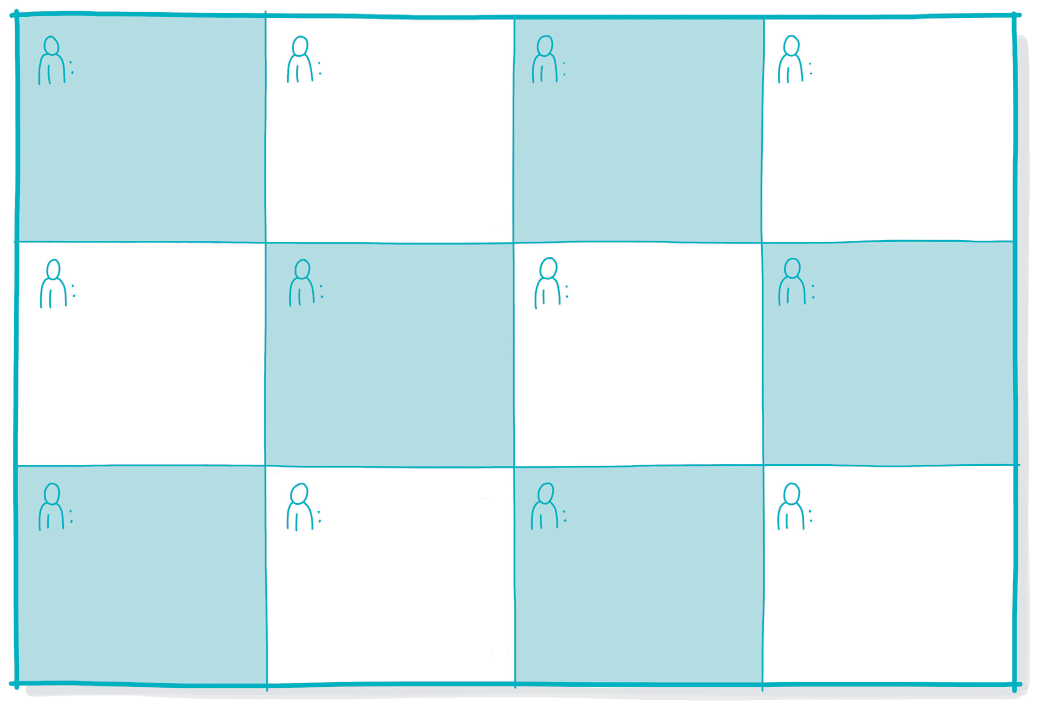TIN KALEIDOSCOPES AND THE TYRANNY OF URGENCY – TWO MODELS TO HELP YOU ACE YOUR MEETINGS
In Section 2 I introduced you to the reasons why you should take a visual approach in your meetings, where this visual way of working has evolved from, your meeting culture and the characters you might meet along the way. In this section I will explain two approaches which will firstly help you refine your thinking as you prepare to lead your meetings, and secondly serve to make your meetings more productive and engaging with the support of powerful visual tools.
TIN KALEIDOSCOPES
When you were child you may have owned one of these – a tin kaleidoscope. Although less likely to make it to the Christmas toy top 10 now, the kaleidoscope is a fascinating toy that delivers completely different results every time it is played with.

The term ‘kaleidoscope’ originated from the early 1800s and derives from the Ancient Greek ‘kalos’ – meaning beauty; ‘eidos’ – meaning that which is seen in form and shape; and ‘skepeo’ – meaning to look, examine and observe beautiful forms (source: Wikipedia). Although very simple in construction, the kaleidoscope is a wonderful visual tool, and probably one we learn to appreciate more as adults than as children.
With more years of experience running meetings than we can remember, my business partners and I wanted to find a simple visual way of conveying the key elements that should form the primary focus of any meeting leader. We had seen plenty of concepts and models on our travels but finding one that resonated with us was proving tricky, until we came across a simple tin kaleidoscope, and the rest is history.
The beauty of the kaleidoscope is that it only takes a very small turn to create a different visual image through the lens, and this is a perfect metaphor for your work as a meeting leader, where you are constantly making small changes and interventions which affect the meetings you lead.
For example, there will be times when you ask a very simple question in the meeting, invite a quiet participant into the conversation, or focus the group’s attention on a particular chart or slide. Like the small turn of the kaleidoscope, every small ‘move’ you make as a meeting leader will have an impact upon your meeting, whether you make those ‘moves’ consciously or not.
It’s time for me to introduce you to the Meeting Kaleidoscope, and how this simple tool can help you make effective choices with the visual information you choose to use in your meetings.

The Meeting Kaleidoscope is comprised of three core interdependent elements – Content, Process and People, held together by a central point – Purpose. You can discover much more about this model in The Meeting Book by my business partner Helen Chapman; however I will outline the tool here and add an emphasis on visual information.
PURPOSE
At the core of the Meeting Kaleidoscope is Purpose. This should always be the starting point for your meeting – every time.

How many meetings have you attended where the purpose of the meeting is unclear, or completely unknown? It’s astounding how many people tell me they accept meeting invitations from colleagues when they have absolutely no idea what the meeting is about or why they need to attend; nonetheless they go ahead and attend without seeking clarification as to why. This is ridiculous!
If you wish to avoid being the leader of one of these meetings, ask yourself this question right now…
‘Is the purpose of the next meeting I am running fully aligned with my organisation’s purpose?’
It doesn’t matter at all what the purpose of your organisation is. It could be manufacturing hi-tech vacuum cleaners, growing trees, caring for animals, exploring Mars, finding the cure for cancer, or delivering cost-effective services through the internet. The point is that the purpose of your meeting must be in complete alignment with that of your organisation and, if it’s not, then why are you bothering? There are millions of meetings taking place around the world each day that have no clear purpose and do not serve their organisation – please don’t make your meeting one of those.
What’s your organisation’s purpose? You may know it intimately, but if not it’s worthwhile checking and noting it down in the thought bubble below. By the way, if you don’t know you won’t be the first or last person not to. Simply by identifying it here could help you to communicate it to others who may be in the same position as you.
Check the agenda of your next meeting. From which items on your agenda can you draw a metaphorical ‘straight line’ to why your organisation exists? If there are items on the agenda that do not link to the organisation’s purpose remove them and find another way of addressing those points. Maybe they could be dealt with by e-mail?
In the simple table below, list the items you are planning to discuss at your next key meeting, and consider whether they truly align with the purpose of both your organisation and your meeting. For those that you tick ‘Not aligned’, find another way to approach these points which saves you valuable time for the points that are aligned.
If there’s one thing you can do now that will start to differentiate your meetings from others it is clearly communicating the purpose to the people you invite in advance.
Do you remember the meeting scenarios mentioned earlier? Here are two contrasting e-mails inviting participants to the meeting. You will be able to guess which e-mail belongs to which meeting!

I guarantee you that your participants will feel more engaged and informed just by telling them why the meeting is important, and why they need to be there. Try it and see what happens.
CONTENT
Purpose draws together the three core components of the kaleidoscope. The first is Content.

It is truly difficult to have a meeting without content. The content includes the data and information we explored previously. Strategy, business plans, performance figures, health and safety reports and spontaneous content that is offered by meeting participants in conversation.
Step 1: Does your content align with your meeting purpose?
Check that the content you are proposing to discuss aligns with and serves your meeting purpose. If your meeting purpose is aligned to your organisation’s purpose then your content should be too.
If the content you are proposing to introduce into the meeting does not serve the purpose it will create an unnecessary distraction and will not be adding any value. Don’t include it.
Step 2: How can I best communicate this content?
Ask what’s the most effective way of communicating and sharing this content with your meeting participants, both before and during the meeting, so that it serves the people in your meeting to have productive conversations and make the best decisions.
The choices you make about the content will, like the ‘moves’ you make in the meeting itself, impact upon the success of your meeting. If you keep in mind that the content you use forms a ‘twist’ of your kaleidoscope, then you are starting in the right frame of mind.
Sadly, the consequence of not considering content carefully either before or during the meeting can be seen in Section 2, such as the prevalence of the Bomber or the Blanket.
PEOPLE
If you thought having a meeting without content was difficult, try having a meeting without People. Some say that meetings would be perfect if it wasn’t for the people attending and, whilst this might appear to be true in some cases, the fact is that people tend to be incredibly useful in meetings!
Just as you asked yourself whether the content of your meeting served your meeting’s purpose, so you should test whether the people you have invited to your meeting are the right people to be there. We know from experience it is tempting to invite a range of people in the hope that most will be able to attend, or that some will bring knowledge of the content and will be able to contribute something of value. The reality is that many attend meetings without any understanding as to why they have been invited, and if it’s not obvious to them, is it obvious to you?
Warning! It’s easy to invite people to our meetings whom we consider to be similar to us. We’ve all done it, probably because we regard these people as having a similar perspective to us, or they are likely to be in agreement with what we are aiming to achieve. After all, how tempting is it to invite someone to your meeting who you know is likely to disagree with you or has an even better idea than yours?
Diversity and inclusion must play a key role in whom you invite to your meetings but I urge you to think well beyond the typical definitions of diversity such as gender, age and ethnicity, to a far broader and more versatile definition about diversity of thinking and perspective. Remember, everyone on this planet offers a different perspective – after all no one else can offer the same perspective as you.
In his book The Medici Effect, Frans Johansson explains how diversity of thinking can create a real advantage in the context of innovation. By explaining the distinction between directional ideas (generated by people operating within the same field/discipline) and intersectional ideas (generated by people from different fields/disciplines) he creates a powerful case for embracing difference rather than homogeneity.

Although inviting people with very different perspectives might initially appear inconsistent with your meeting’s purpose, in reality this approach demonstrates powerful thinking when compared to selecting on traditional diversity criteria alone. When planning your next meeting, consider which people might offer valuable and different perspectives.

Earlier you considered your organisation’s purpose, the purpose of your meeting, and the meeting items you need to discuss that are aligned with the purpose. Now build upon your thinking by considering the perspectives you need for each conversation, and who is best to provide them.
PEOPLE AND VISUAL INFORMATION
You’ve reflected on the group of people you wish to invite to your meeting. They demonstrate an impressive diversity of perspective which will add immense value to your content and align with your purpose.
When it comes to selecting visual information to assist this group ask yourself the following questions for each person, bearing in mind that a group is a collection of individuals, and they may have very different preferences.
Add in the name of the people you are planning to invite and what observations you have of them, using the guide questions below. If you don’t know, just ask.
- What do I know about this group’s thinking and working style?
- What types of information do they positively respond to?
- What types of information turn them off?
Reflecting on these questions will help you choose the most effective visual information methods for your meeting, and in Section 6 I will indicate how each tool might impact upon the core element of People.
PROCESS
The third element of the Meeting Kaleidoscope is Process. The first point to make clear is that this is not the agenda, which is a list of topics to be discussed in a meeting in a specific order within the time available.
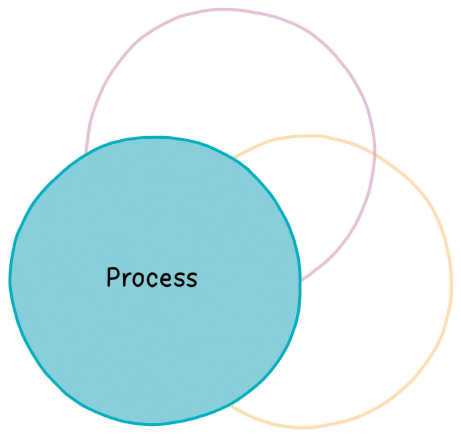
Process goes much deeper than the agenda by focussing on HOW the people in your meeting are going to work with the content at each point in your agenda. Whereas a conventional agenda is often seen as a series of independent points, your process design should incorporate all the items in one overall flow, with each item aligning and building on the other. Process could, in summary, be described as the HOW for your agenda.
It should be obvious that giving time to consider the purpose, content and people before you hold your meeting is critical. It is even more so for the process you design for your meeting, and subsequently the visual tools you intend to use to support the process. The challenge for many people in business is that time to prepare for meetings can be limited. My response is that more productive meetings will get significantly more done – who doesn’t want that?
By this point you will have identified the agenda items for your meeting which align with your meeting’s purpose, and you know whom you will be inviting to the meeting. The next stage is to consider the points on your agenda, and clarify WHAT you are aiming to achieve with each. A simple way of considering each point is to position it on this five-step model developed by Peter Senge. I often share this model, known as the Collaboration Continuum, when designing meetings as it helps to clarify what is expected of the people in the meeting. Each step in this diagram indicates the degree of influence or decision making the group has over the outcome of an agenda point.

At which point on these steps do your meeting points sit? It is important to get this right as your group will be far more engaged if you are clear on what you are expecting of them and the degree of influence they have on a given topic. ‘Sham consultation’ is a common meeting error whereby participants are given the impression that they have influence over the outcome when in fact the decision has already been made.
Your choice of visual tools should complement what you are aiming to achieve at each point in your meeting, in support of your meeting purpose. For example, tools such as slide decks are useful in support of a ‘tell’ session (if you are conveying information about subjects or decisions that are unchangeable), whereas grids are useful for testing (comparing ideas against key criteria such as cost and effort), and drawings are powerful for co-creation (where the important details are determined by the group).
In Section 6 I will describe how each visual tool can support your process. I will also suggest where each tool may be most helpful on the five-step diagram.
The Meeting Kaleidoscope perfectly illustrates your dynamic role as a meeting leader. The meeting is a constantly changing form, and your small ‘moves’ and turns should utilise the content, make the best of the meeting participants, power up the process and nail your meeting outcomes.
It’s time to introduce you to a second approach that I have found immensely useful as a meeting leader, and one that helps me to consider and select visual tools with confidence.
THE TYRANNY OF URGENCY
It’s a fact that in any busy organisation time is hugely precious, and ‘stuff’ just needs to get done. As a result we have been conditioned to believe that long and detailed meetings are a waste of time and we should ‘just get on with it and make a decision now’. I uphold this sentiment, but only in circumstances where just getting on with it and making a decision quickly is the right thing do to, and in many cases this approach serves poor decision making and a lack of commitment.
In this section I would like to introduce you to the work of Sam Kaner, which has underpinned much of my work in leading meetings.
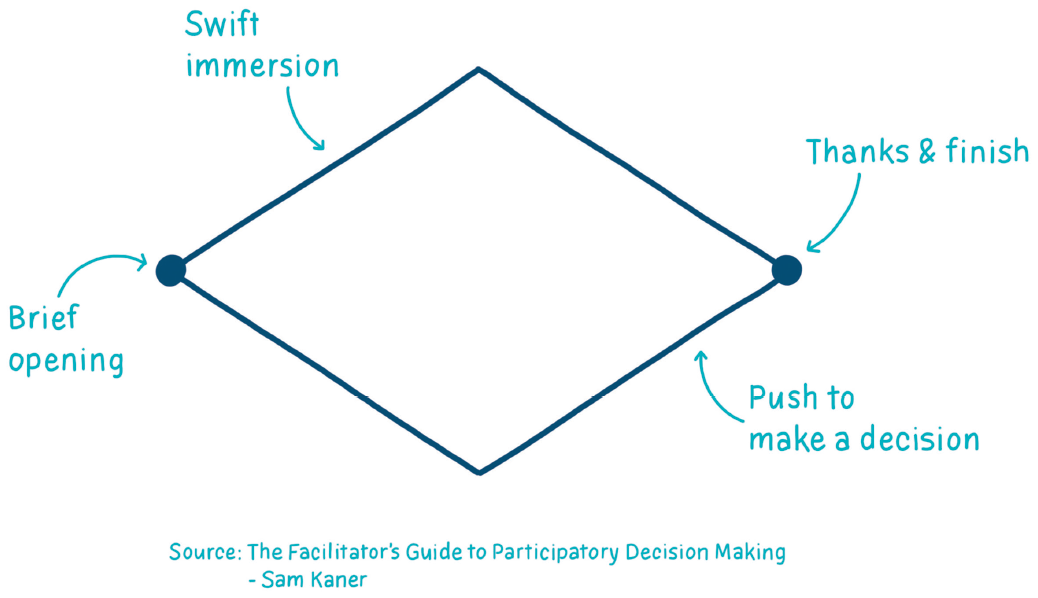
Many meetings in business work like this…
- Brief opening (perhaps referring to the last meeting and who’s here)
- Swift immersion in the key topic to be discussed (time to diverge)
- Push to make a decision on the topic, agreement on who is doing what and when (time to converge)
- Thanks and finish (off to the next meeting?)
The above diagram illustrates how Kaner describes such a meeting in visual form. On the left is the starting point, with a brief divergence to discuss the topic, followed by convergence to the point of making a decision. And this is great, especially when the circumstances demand it. For example, General (‘Storming’) Norman Schwarzkopf Jr. was well known for his brief meetings during the Iraq war where he would stop in the desert with his troops, unfold a map upon the bonnet of his jeep, make a rapid assessment of the current position and make a decision on what to do next. Perfect for that scenario, or quick team updates and project reviews, but not for every situation.

Think of a meeting in which you have participated where a specific topic was discussed in detail for a long time. How did it feel for you? Slow, laborious, difficult? According to Kaner you were probably in the ‘groan zone’. This is the point in a meeting where the group, supported by a meeting leader, focusses on a specific topic for an extended period, which can be frustrating and like ‘walking in treacle’. Whilst being in this zone for the participants might appear difficult, Kaner has shown that by keeping participants in the ‘groan zone’ they are more likely to reach outcomes that they would never have encountered had they converged on the topic earlier and make robust decisions with more commitment.

Below I have illustrated how Kaner describes the flow of a meeting, including the ‘groan zone’. In contrast to the previous diagram you will notice the ‘spiked’ middle section, which holds the group on the topic before converging on a decision. Leading the group at this point can be a challenge for any meeting leader, and if this is something that interests you I urge you to find out more as this could unlock some great outcomes for you and your group.

THE FIVE STAGES OF A SUCCESSFUL MEETING

At The Facilitation Partnership, as we share our thinking on successful meetings with our clients, we have taken inspiration from and built upon this approach to introduce five stages of a successful meeting.
- Opening: Where the meeting starts. Focussing the participants on the meeting’s purpose and desired outcomes, and creating a sense of community and building trust. Everyone is ready to get started on the work to be done.
- Working: Where the action happens. Getting stuck into the content using the intended process for the meeting. By exploring the topic together the group shares perspectives, ideas and insights.
- Stretching: Where the ‘sticky bit’ lies. Resisting the urge to converge and keeping the conversation focussed on the question at hand. Viewing the topic from a different perspective, testing and re-testing assumptions to reach a deeper understanding.
- Deciding: Where converging commences. Based on the exploration during the Working and Stretching stages, the group decides on what decisions to make.
- Moving: Where the momentum builds. The decisions have been made after much careful and detailed dialogue. This is the point where the group focusses on turning the decisions into action. Who will do what, when and how?
Source: The Facilitation Partnership Limited
For each of these stages there are decisions you need to make as a meeting leader about the visual tools you might use to support each stage, taking into consideration the content to be discussed, the people in the room, and your adopted process. Here are five examples to help you start your thinking:

Do you recognise the above stages in your own meetings? Clearly there will be stages that you might recognise more than others, and indeed most stages, including the Opening, Working, Deciding and Moving, are generally to be found in all meetings, or at least they should be if the meetings are to be productive and successful in achieving their desired outcomes.
In Section 6 I will outline the various visual tools you can use in your meetings. I will also suggest which tools might be useful for the different stages of a successful meeting.
In the next section we will venture into another meeting world which has become increasingly common in our everyday lives – virtual meetings.
THE GOLDEN NUGGETS
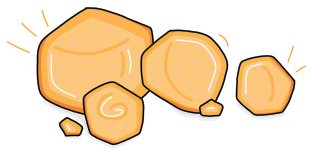
- We frequently make small changes to how we run our meetings, all of which will have an impact on the group.
- The Meeting Kaleidoscope and the five stages of a successful meeting will act as your guide when planning and designing your meetings.
- Resist the urge to accept meeting invitations when you don’t know the meeting purpose and why your presence is needed.
- Your meeting purpose must align with your organisation’s purpose.
- The content you choose to discuss, the people you invite to the meeting, and the process you choose to adopt must align with your meeting’s purpose.
- Leading your participants into the ‘groan zone’, where appropriate, will lead to richer conversation and commitment to decisions that stick.
